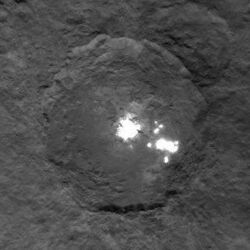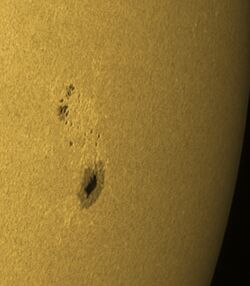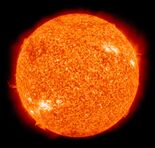Astronomy:Facula

A facula /ˈfækjʊlə/ (plural: faculae /ˈfækjʊliː/), Latin for "little torch", is literally a "bright spot". The term has several common technical uses. It is used in planetary nomenclature for naming certain surface features of planets and moons,[1] and is also a type of surface phenomenon on the Sun's photosphere. In addition, a bright region in the projected field of a light source is sometimes referred to as a facula, and photographers often use the term to describe bright, typically circular features in photographs that correspond to light sources or bright reflections in a defocused image.
Solar facula

Solar faculae are bright spots in the photosphere that form in the canyons between solar granules, short-lived convection cells several thousand kilometers across that constantly form and dissipate over timescales of several minutes. Faculae are produced by concentrations of magnetic field lines. Strong concentrations of faculae appear in solar activity, with or without sunspots. The faculae and the sunspots contribute noticeably to variations in the "Solar constant". The chromospheric counterpart of a facular region is called a plage.[citation needed]
Cererian facula
Cererian faculae were initially speculated to suggest current or past outgassing[2] on Ceres, perhaps due to volcanism or cometary activity. The brightest cluster of spots (Cereale Facula) is located in the center of an 80-kilometer (50 mi) crater called Occator.[3][4] These bright features have an albedo of about 40%, four times brighter than the average of Ceres's surface.[5] The spots appear to be mostly sodium carbonate (Na2CO3), implying that hydrothermal activity followed by evaporation of the water is probably what created the spots.[6][7]
References
- ↑ Sixth Close Titan Flyby, ESA, 16 August 2005, http://sci.esa.int/cassini-huygens/37802-titan-flyby-22-08-05/, retrieved 18 February 2015.
- ↑ LPSC 2015: First results from Dawn at Ceres: provisional place names and possible plumes
- ↑ Staff (13 July 2015). "USGS: Ceres nomenclature". USGS. http://planetarynames.wr.usgs.gov/images/ceres.pdf.
- ↑ Staff (6 July 2015). "Planetary Names: Crater, craters: Occator on Ceres". USGS. http://planetarynames.wr.usgs.gov/Feature/15341.
- ↑ Rayman, Marc (8 April 2015). Now Appearing At a Dwarf Planet Near You: NASA's Dawn Mission to the Asteroid Belt (Speech). Silicon Valley Astronomy Lectures. Foothill College, Los Altos, CA. Archived from the original on 2021-12-21. Retrieved 2018-07-07.
- ↑ Landau, Elizabeth; Greicius, Tony (29 June 2016). "Recent Hydrothermal Activity May Explain Ceres' Brightest Area". NASA. http://www.nasa.gov/feature/jpl/recent-hydrothermal-activity-may-explain-ceres-brightest-area.
- ↑ De Sanctis, M. C.; Raponi, A.; Ammannito, E.; Ciarniello, M.; Toplis, M. J.; McSween, H. Y.; Castillo-Rogez, J. C.; Ehlmann, B. L. et al. (2016-06-29). "Bright carbonate deposits as evidence of aqueous alteration on (1) Ceres". Nature 536 (7614): 54–57. doi:10.1038/nature18290. PMID 27362221. Bibcode: 2016Natur.536...54D.


